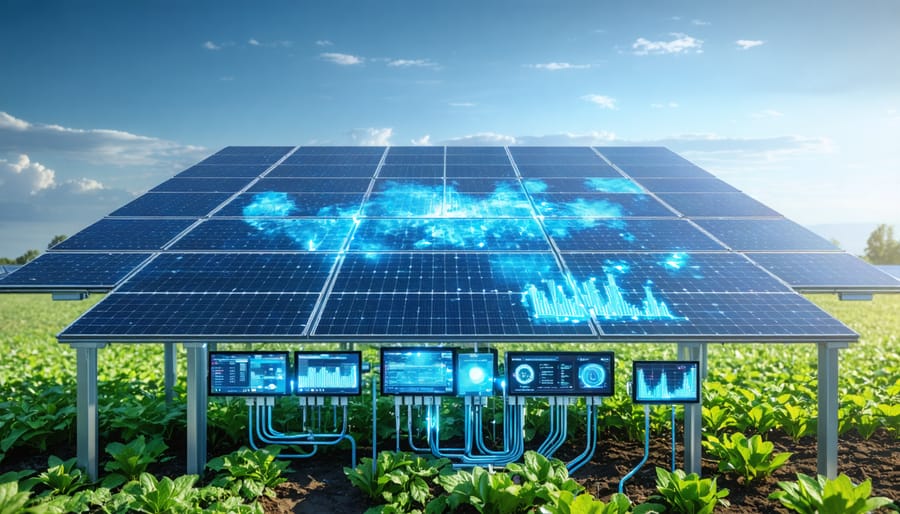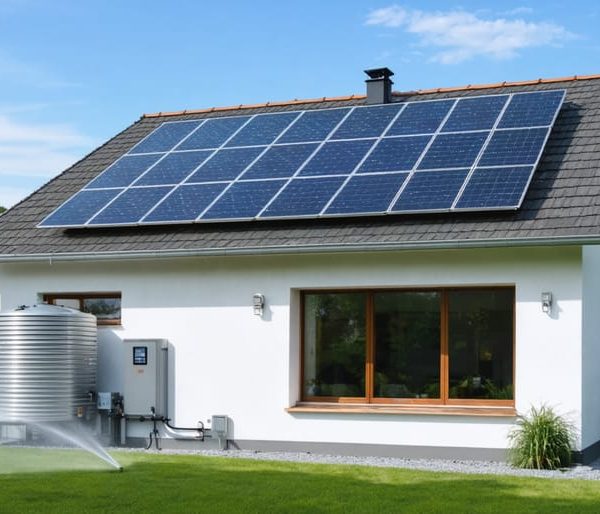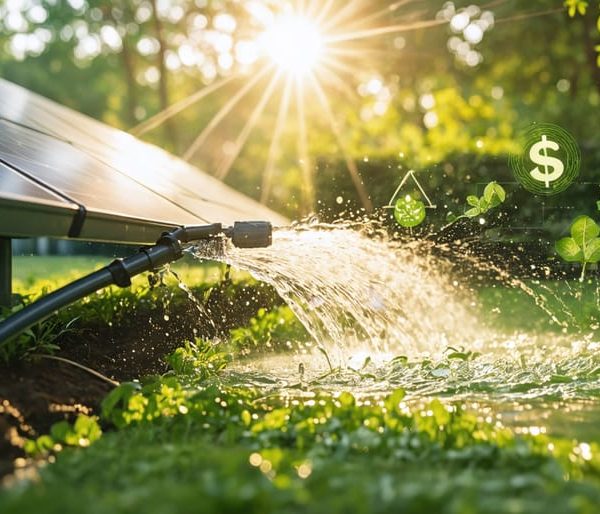Solar-Powered Groundwater Management: The Smart Way to Protect Your Water Resources
Groundwater management has become a critical cornerstone of sustainable property development, requiring thoughtful planning and innovative solutions. By implementing solar-powered water systems, property owners can achieve both environmental stewardship and significant cost savings. Modern groundwater management plans integrate real-time monitoring technology, sustainable extraction practices, and renewable energy solutions to protect this precious resource for future generations.
The growing pressure on groundwater resources, combined with increasing energy costs, has sparked a revolution in how we approach water management. Smart meters, automated controls, and advanced filtration systems now work together to create comprehensive management solutions that optimize water usage while minimizing environmental impact. These innovations make it possible for property owners to reduce their water consumption by up to 30% while maintaining optimal performance.
By adopting a well-designed groundwater management plan, properties can ensure long-term water security, reduce operational costs, and contribute to environmental sustainability. The key lies in understanding local hydrogeology, implementing appropriate technology, and maintaining regular monitoring systems that adapt to changing conditions.
Understanding Your Groundwater System
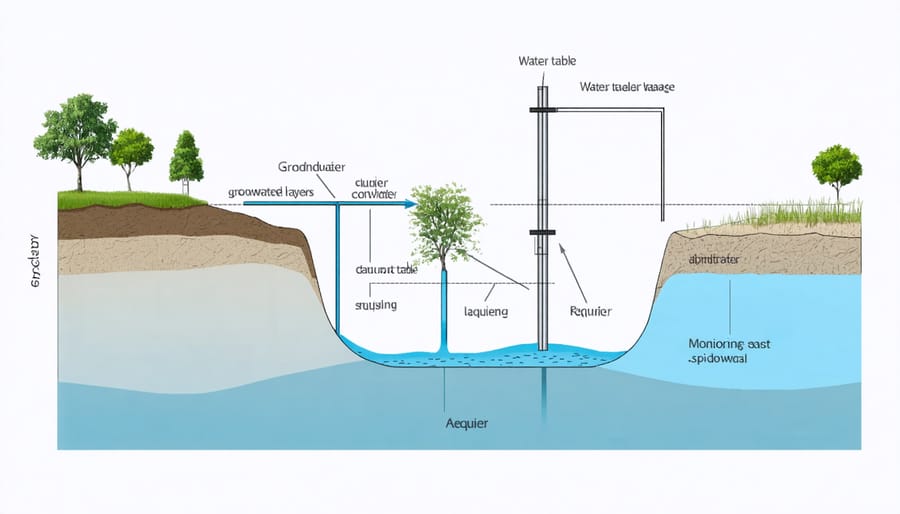
Mapping Your Water Resources
Modern technology has made groundwater monitoring more accessible and precise than ever before. Start by installing monitoring wells equipped with digital sensors that track water levels in real-time. These smart sensors can measure depth, quality parameters like pH and salinity, and even flow rates.
Connect your monitoring system to a data logger or smartphone app to create detailed water resource maps. Many of these systems use solar power, making them energy-efficient and perfect for remote locations. They can alert you when water levels drop below critical thresholds or when quality parameters change significantly.
Geographic Information System (GIS) mapping tools help visualize your groundwater resources across your property. By overlaying this data with geological maps and weather patterns, you can better understand your aquifer’s behavior and plan accordingly.
Regular water quality testing is essential. Use portable testing kits for basic parameters and send samples to certified labs quarterly for comprehensive analysis. Keep detailed records of all measurements – this historical data is invaluable for tracking trends and making informed decisions about your water usage and conservation strategies.
Remember to calibrate your monitoring equipment regularly to ensure accurate readings.
Common Groundwater Challenges
Property owners and managers often face several key challenges when it comes to groundwater management. In urban areas, the biggest concerns include groundwater depletion due to excessive pumping, contamination from industrial activities, and saltwater intrusion in coastal regions. Urban development and the increasing amount of impervious surfaces, like concrete and asphalt, also reduce natural groundwater recharge.
Rural areas face their own set of challenges, primarily related to agricultural practices. Overuse of fertilizers and pesticides can lead to groundwater contamination, while intensive irrigation can cause rapid aquifer depletion. Many rural communities also struggle with naturally occurring contaminants like arsenic and iron, which require specialized treatment systems.
Both urban and rural settings commonly deal with aging infrastructure, including leaking pipes and outdated wells, which can waste precious groundwater resources. Climate change adds another layer of complexity, as changing precipitation patterns affect groundwater recharge rates. Additionally, many regions lack proper monitoring systems to track groundwater levels and quality, making it difficult to implement effective management strategies.
Understanding these challenges is the first step toward developing sustainable solutions that protect our valuable groundwater resources.
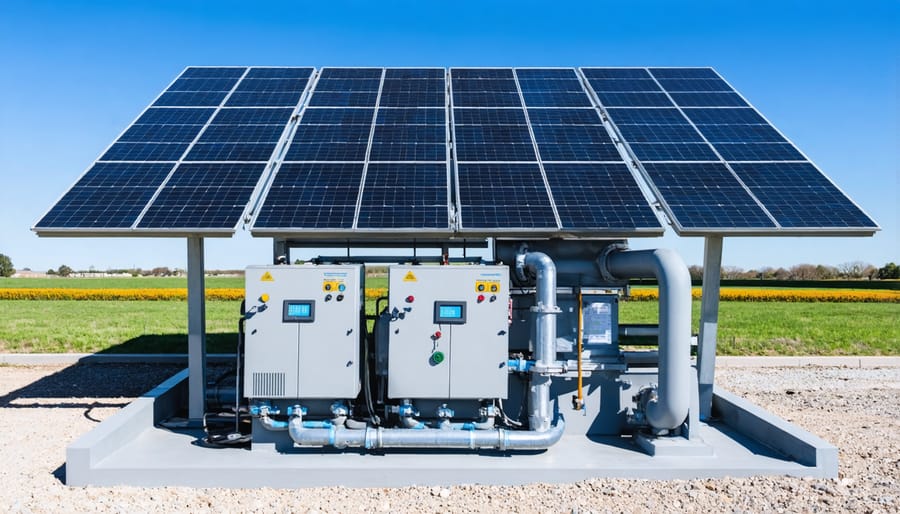
Solar-Powered Solutions for Water Management
Smart Monitoring Systems
Modern groundwater management has been revolutionized by the integration of solar-powered monitoring systems, making water level tracking both sustainable and efficient. These smart systems use advanced sensors powered by solar energy to provide real-time data about groundwater conditions without relying on the electrical grid.
The heart of these monitoring systems consists of solar panels connected to specialized sensors that measure various parameters, including water levels, flow rates, and quality indicators. The panels generate clean energy during daylight hours, while built-in batteries store excess power for continuous operation during nighttime and cloudy conditions.
These systems typically include wireless transmitters that send data to a central monitoring station or cloud-based platform, allowing property managers to track groundwater metrics from their smartphones or computers. This instant access to information helps identify potential issues before they become serious problems.
Installation is straightforward: solar panels are mounted in a sunny location, connected to the monitoring equipment, and calibrated to local conditions. Many systems now feature user-friendly interfaces that make data interpretation simple for non-technical users.
The benefits are compelling: reduced energy costs, minimal maintenance requirements, and reliable operation in remote locations. Property owners report significant cost savings and improved water management efficiency after switching to solar-powered monitoring systems. Plus, these systems contribute to sustainability goals while providing essential data for informed decision-making in groundwater management.
Automated Pumping Solutions
Modern groundwater management has been revolutionized by solar-powered pumping systems, offering an eco-friendly and cost-effective solution for water extraction and distribution. These innovative systems combine the reliability of traditional pumping methods with the sustainability of off-grid solar solutions, making them ideal for both residential and commercial properties.
The heart of these automated systems consists of solar panels, a controller, and an efficient pump that works in harmony to draw and distribute groundwater. During daylight hours, the solar panels convert sunlight into electricity, powering the pump without relying on the grid. Smart controllers monitor water levels and system performance, automatically adjusting pumping rates to optimize water extraction while preventing aquifer depletion.
Installation is straightforward: solar panels are mounted in a sunny location, connected to the controller, which then powers the submersible pump. Many systems now include remote monitoring capabilities, allowing users to track performance through smartphone apps. Property owners report significant cost savings, with some seeing up to 70% reduction in water management expenses.
Maintenance is minimal, typically requiring only occasional panel cleaning and routine system checks. The absence of fuel costs and moving parts means these systems can operate reliably for 15-20 years, making them a smart long-term investment in sustainable water management.
Water Quality Management
Solar-powered treatment and filtration systems represent a revolutionary approach to maintaining groundwater quality while minimizing environmental impact. These innovative efficient water management systems harness the sun’s energy to power various treatment processes, from basic filtration to advanced purification methods.
The system typically consists of solar panels connected to pumps, filters, and UV sterilization units. When sunlight hits the panels, they generate electricity to power the treatment components, making the entire process energy-independent. This setup is particularly valuable in remote locations or areas with unreliable power supply.
Modern solar-powered filtration systems can remove sediments, harmful bacteria, and chemical contaminants while requiring minimal maintenance. Many systems now come with smart monitoring capabilities, allowing users to track water quality parameters through mobile apps. This real-time data helps in making informed decisions about water treatment needs.
The benefits extend beyond environmental considerations. Property owners often see significant cost savings on their energy bills, and the systems typically pay for themselves within 3-5 years. Additionally, these systems can operate during power outages, ensuring continuous access to clean water.
To maximize efficiency, many installations include storage batteries, enabling the system to function during cloudy days or at night. This ensures consistent water quality management regardless of weather conditions.
Implementation Steps
Planning Your System
Before implementing your groundwater management plan, you’ll need to carefully assess your property’s unique characteristics and design a system that meets your specific needs. Start by conducting a thorough site evaluation, including soil type, groundwater depth, and local precipitation patterns. This information will help you determine the most effective management strategies.
Consider your water usage patterns and goals. Are you primarily focused on conservation, sustainable irrigation, or preventing groundwater contamination? Understanding your objectives will guide your system design choices.
Map out existing wells, water sources, and drainage patterns on your property. This visual representation helps identify potential problem areas and opportunities for improvement. Don’t forget to check local regulations and permit requirements – these will influence your system’s design and implementation.
Next, evaluate your budget and available resources. While some solutions might require significant upfront investment, they often pay off through reduced water costs and improved property value. Consider phasing your implementation if budget constraints exist.
Technology integration is crucial for modern groundwater management. Consider installing monitoring systems to track water levels, quality, and usage patterns. Smart sensors and automated controls can help optimize water use while minimizing waste.
Finally, develop a timeline for implementation and maintenance schedules. A well-planned system should include regular monitoring points and clear procedures for adjusting strategies based on performance data. Remember, flexibility in your plan allows for adjustments as conditions change or new technologies become available.
Installation and Maintenance
Installing a groundwater management system requires careful planning and regular maintenance to ensure optimal performance. Start by conducting a comprehensive site assessment to understand your groundwater conditions, including flow patterns and water table levels. This initial evaluation will help determine the most effective monitoring well locations and system components.
For installation, work with certified professionals to:
– Set up monitoring wells at strategic points
– Install water level sensors and data loggers
– Configure automated sampling equipment
– Establish a centralized control system
Once your system is in place, implement these essential maintenance practices:
1. Regular Well Inspection
– Check well casings monthly for damage
– Clean screens and filters quarterly
– Test pump functionality every six months
2. Data Management
– Download and backup monitoring data weekly
– Calibrate sensors every three months
– Update software systems as needed
3. Water Quality Testing
– Conduct basic water quality tests monthly
– Perform comprehensive analysis quarterly
– Document all test results systematically
4. System Optimization
– Review performance metrics bi-annually
– Adjust extraction rates based on data
– Update management strategies as needed
Remember to keep detailed maintenance logs and schedule professional inspections annually. This proactive approach helps prevent system failures and ensures sustainable groundwater management for years to come.
Many property owners report that setting reminders for these maintenance tasks through digital calendars helps them stay on track with their management plan.
Cost Benefits and Environmental Impact
Implementing a comprehensive groundwater management plan offers substantial financial benefits while promoting environmental sustainability. Property owners who invest in these systems typically see a return on investment within 3-5 years through reduced water utility costs and decreased energy consumption. When combined with a cost-effective solar investment, the savings can be even more significant, often reaching 40-60% reduction in overall water management expenses.
The environmental advantages are equally compelling. Well-designed groundwater management systems help preserve local aquifers by preventing over-extraction and maintaining natural groundwater levels. This preservation is crucial for ecosystem health and ensures sustainable water availability for future generations. Studies show that properties implementing these plans typically reduce their water consumption by 30-45% compared to traditional water management approaches.
Another significant benefit is the reduction in carbon footprint. Solar-powered pumping systems eliminate the need for grid electricity or diesel generators, potentially preventing up to 2.5 tons of CO2 emissions annually for an average commercial property. The system also helps prevent soil erosion and maintains proper drainage, which protects local flora and fauna.
Property managers report additional benefits, including:
– Lower maintenance costs due to automated monitoring systems
– Reduced risk of water-related property damage
– Enhanced property value due to sustainable infrastructure
– Compliance with increasingly strict environmental regulations
– Improved drought resilience
The initial investment in groundwater management infrastructure is offset by long-term savings and environmental benefits. Many regions offer tax incentives and rebates for implementing these systems, making the financial case even more attractive. When combined with other green initiatives, these plans contribute to a property’s overall sustainability profile while providing tangible economic advantages.
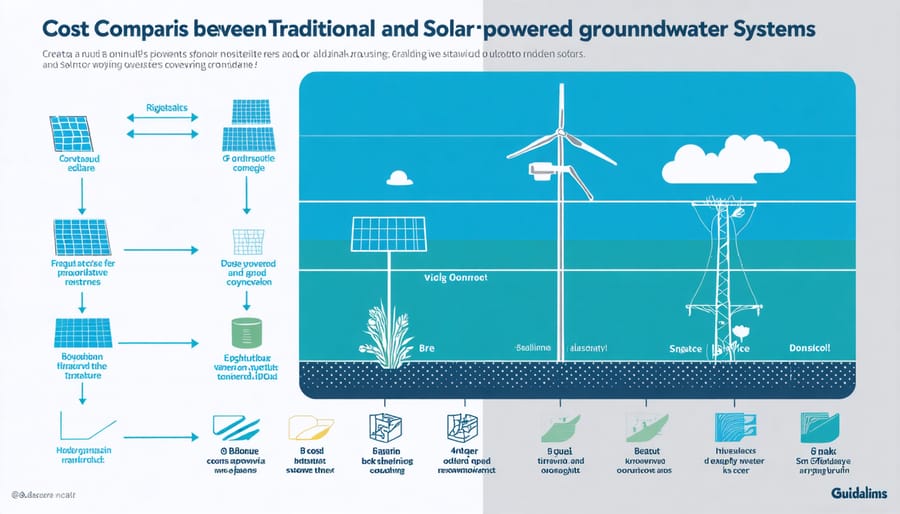
Implementing a groundwater management plan is not just an environmental responsibility – it’s an investment in our future and a smart way to protect our most precious resource. By following the guidelines and strategies outlined in this article, you can take meaningful steps toward sustainable water usage while potentially reducing your operational costs.
Remember that successful groundwater management combines monitoring, conservation, and smart technology. Start with a thorough assessment of your current water usage patterns, implement the suggested monitoring systems, and gradually incorporate solar-powered solutions for maximum efficiency. The initial investment in solar-powered pumping systems and monitoring equipment will pay dividends through reduced energy costs and improved water conservation.
Don’t forget that every property is unique, and your management plan should be tailored to your specific needs and local conditions. Work with local experts and authorities to ensure compliance with regulations while maximizing the effectiveness of your plan. Regular review and adjustment of your strategies will help maintain optimal performance and adapt to changing conditions.
By taking action today, you’re not only protecting groundwater resources but also contributing to a more sustainable future. Whether you’re a homeowner or property manager, your efforts in responsible groundwater management make a real difference in preserving this vital resource for generations to come. Start small, think long-term, and remember that every drop counts in our journey toward sustainable water management.

